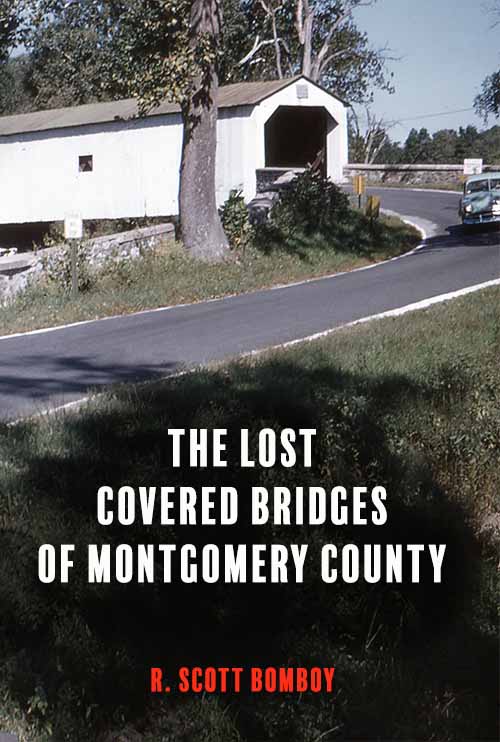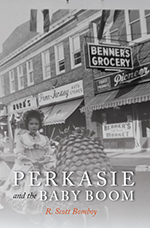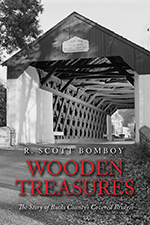Today, some people may take for granted the 122-acre Lake Lenape Park that connects Perkasie and Sellersville Boroughs via the East Branch of the Perkiomen Creek. However, the park almost did not come to pass until local leaders joined with federal and county officials in 1935 to create a gift to “the children of the future,” as one leader called it.

The Park’s Roebling bridges in the early 1940s
Two men were the primary visionaries behind the Lake Lenape Park project: David D. Cressman of Sellersville and Bucks County Works Progress Administration (or WPA) chief engineer William Wilhelm.
Records recently discovered in Perkasie Borough’s archives show Wilhelm and the WPA championed the park project and asked for the iconic twin Roebling suspension bridges to be installed over the creek that runs through the park today.
The WPA was a big factor in Perkasie and Sellersville between 1935 and 1941. The various projects the WPA financed included streets, sidewalks, and parks. The WPA also helped pay for a borough hall in Sellersville and its post office. In 1939 alone, the WPA employed more than 1,000 people in Bucks County who needed jobs.
Cressman had advocated for the restoration of the original Lake Lenape in Sellersville in 1930. In the 1890s, the owners of the old Menlo Amusement Park used a rudimentary dam to create a small lake used for boating, fishing, and ice skating. By 1930, the dam deteriorated, and the former “lake” was a muddy, narrow stream. Cressman, Sellersville’s Parkway Commission, and the Branch Valley Fish and Game Association sought local and county funding to put in a new dam in Sellersville.
The project’s key moment came in October 1935 when Perkasie Borough agreed to join the effort, which the WPA would mostly fund. The entire run of the East Branch creek from Walnut Street in Perkasie to the Bethlehem Pike in Sellersville would now be called “Lake Lenape.”
Sellersville contributed 22 acres to the park, while Perkasie and the Bucks County commissioners bought the 30-acre lower section of Menlo Park from its owner, Henry Wilson. In turn, Wilson used the money to build a new cement pool in Menlo Park.
Perkasie’s part of the project was $122,000, with 95 percent of the costs coming from labor paid for by the WPA. Sellersville’s portion would cost $68,000. Most of the park’s expenses came from installing the new dam in Sellersville, dredging the creek, straightening the creek, planting new trees, building boat launches, and removing landfill. Somewhere between 70 and 140 workers were used, at a rate of $2 an hour, for the manual labor. The workers came from the WPA rolls of the local unemployed.
In March 1936, WPA engineer Wilhelm began supervising the construction of a new dam in Sellersville. The new structure was filled with water in July 1937 after the creek had been widened and deepened. An issue that apparently complicated the plan was the disposition of floodwaters. One solution was the innovative use of landfill dirt to create an artificial island in the creek on Perkasie’s side of the project.

Boat launches, with the island and bridge in The background, September 1937.
In August 1936, Perkasie Borough Council approved the idea of a footbridge that incorporated the island as part of the bridge. At that point, the island was still under construction. The WPA presented its footbridge plans to Council in January 1937. Engineer Alan G. Orr from United Constructors & Engineers of Philadelphia showed a plan with two bridges that linked the island, with towers and cabling that resembled the famed suspension bridges of John A. Roebling & Sons of New Jersey. At the time, Roebling & Sons was also working on the Golden Gate Bridge project in California. Council asked Orr to tell Wilhelm the project was approved.
In February, Orr and Wilhelm sent the bridge plans to Perkasie Borough. The plans showed the use of a wire rope suspension system supported by concrete towers. One bridge spanned 54 feet; the other 90 feet. Both required a considerable amount of concrete footers and other materials.

Original bridge plans, courtesy Perkasie Borough
In April, the Borough advertised for contractors with a requirement the suspension system had to meet Roebling’s specifications. The only company that bid on the suspension system was Roebling, at an approximate cost of $2,000.
After the Lake Lenape dam was filled, the project’s final major task was building the twin bridges. The total bridge project cost was about $6,500 for all materials, including concrete, crushed stone, and lumber bought from Perkasie businesses such as Sine’s, Moyer’s Lumber, and Kulp Hardware.
The new lake and the bridges were in public use about one month before the park’s official dedication on September 11, 1937. Two weeks before the ceremony the “lake” was stocked with 1,200 largemouth and smallmouth bass. The park’s opening was hailed as a major moment in the history of Perkasie and Sellersville. State deputy attorney general Edmund Kirby was an honored guest. “This is a purely humanitarian project,” he said. “It is placed here with the hope that it will bring many pleasant days to children of the future in return for the efforts put forth in its construction. … It is placed here for the good of all,” Kirby said.
The Lake Lenape Park project was not without controversy. During construction, water management issues forced raw sewage out of manholes near the dam. And some Perkasie residents were upset that proceeds from the Borough’s electric company were used to fund the Borough’s costs for materials.
Over time, the scope and nature of Lake Lenape Park have changed. The biggest change was the acquisition in 1956 of 44 acres used to add ball fields and later a covered bridge near Walnut Street in Perkasie. Sellersville added its Veterans Memorial in 1983, and new trails were added on a former trolley right of way.

The Roebling bridges a month after their completion
Still, the heart and soul of Lake Lenape Park is the parkway and trail system added in 1937.
On May 27, 2015, the Pennsylvania State Historical and Museum Commission determined that Lake Lenape Park is eligible for the National Register of Historic Places. “It appears that the Park is locally significant for its association with the early 20th century movements to develop recreational and natural resources in Pennsylvania and retains sufficient integrity to reflect that significance and association,” the commission said. That decision came before recently discovered records showing the WPA’s direct involvement in planning the park.
Perhaps the best tribute to the Park would be its official listing as a National Historic District. That would require a joint effort between Perkasie Borough and Sellersville Borough. Time will tell if that happens, but it wouldn’t be the first time the two Boroughs acted together “for the good of all.”






